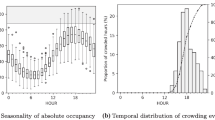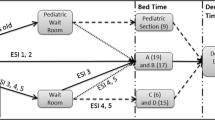Abstract
Emergency department (ED) crowding is a common challenge for hospitals across the globe. The efficiency and effectiveness of ED services can be improved through identifying the causing ED crowding and modeling the prediction of ED crowding. The nature of ED crowding involves a complex dynamics of intertwined processes and workflows among the different departments within a hospital; thus, the problem cannot be tackled by examining ED alone. It is important to build a model which can identify the factors causing ED crowding and validate the coping strategies of hospitals. This study proposes an intelligence model which first introduces the well-know decision tree method to fit an accommodated nonlinear association and obtain intelligent grading rules of ED crowding; Then it integrates the intelligent grading rules and indexes of coping strategies to construct a hierarchical linear model. The results simultaneously solved traditional modeling issue of high correlation among independent variables and un-convergence. It also provides a better illustration of ED crowding phenomena with more accurate model fitting, as well as a clear linkage between coping strategies and the factors causing ED crowding. Furthermore, our proposed model can have a better understanding of problem nature and guild a better bed management for decision makers. It can also detect intelligently whether hospitals have drawn up active or passive bed management strategies to cope with ED crowding.
Similar content being viewed by others
References
Asaro P. V., Lewis L. M., Boxerman S. B. (2007) Emergency department overcrowding: Analysis of the factors of renege rate. Academic Emergency Medicine 14(2): 157–162
Asaro P. V., Lewis L. M., Boxerman S. B. (2007) The impact of input and output factors on emergency department throughput. Academic Emergency Medicine 14(3): 235–242
Asplin B. R., Magid D. J., Rhodes K. V., Solberg L. I., Lurie N., Camargo C. A. Jr. (2003) A conceptual model of emergency department crowding. Annals of Emergency Medicine 42(2): 173–180
Bernstein S. L., Verghese V., Leung W., Lunney A. T., Perez I. (2003) Development and validation of a new index to measure emergency department crowding. Academic Emergency Medicine 10(9): 938–942
Brown H., Prescott R. (2006) Applied mixed models in medicine (2nd ed). Hoboken, NJ: John Wiley, Chichester, England
Bureau of National Health Insurance, D. O. H., Executive Yuan. (2010). National Health Insurance in Taiwan 2010.
Chien C.-F., Chen L.-F. (2008) Data mining to improve personnel selection and enhance human capital: A case study in high-technology industry. Expert Systems with Applications 34(1): 280–290
Chien C.-F., Tseng F.-P., Chen C.-H. (2008) An evolutionary approach to rehabilitation patient scheduling: A case study. European Journal of Operational Research 189(3): 1234–1253
Chien C.-F., Wang W.-C., Cheng J.-C. (2007) Data mining for yield enhancement in semiconductor manufacturing and an empirical study. Expert Systems with Applications 33(1): 192–198
Chuang S., Inder K. (2009) An effectiveness analysis of healthcare systems using a systems theoretic approach. BMC Health Services Research 9: 195
Epstein S. K., Tian L. (2006) Development of an emergency department work score to predict ambulance diversion. Annals of Emergency Medicine 13(4): 421–426
Fisher J., Sokolove P. E., Kelly S. P. (2009) Overcrowding: Harming the patients of tomorrow?. Academic Emergency Medicine 16(1): 56–60
Forero, R., & Hillman, K. (2008). Access block and overcrowding: A literature review. Prepared for the Australasian College for Emergency Medicine. Avilable at: http://www.acem.org.au/media/media_releases/Access_Block_Literature_Review_08_Sept_3.pdf. Accessed 05 January 2009.
Green M., Bjork J., Forberg J., Ekelund U., Edenbrandt L., Ohlsson M. (2006) Comparison between neural networks and multiple logistic regression to predict acute coronary syndrome in the emergency room. Artificial Intelligence in Medicine 38(3): 305–318
Greene J. (2007) Emergency department flow and the boarded patient: How to get admitted patients upstairs. Annals of Emergency Medicine 49(1): 68–70
Hoot N. R., Aronsky D. (2008) Systematic review of emergency department crowding: Causes, effects, and solutions. Annals of Emergency Medicine 52(2): 126–136
Hoot, N. R., Epstein, S. K., Allen, T. L., Jones, S. S., Baumlin, K. M., Chawla, N. et al. (2009) Forecasting emergency department crowding: An external, multicenter evaluation. Annals of Emergency Medicine, 54(4), 514–522.e519
Hoot N. R., LeBlanc L. J., Jones I., Levin S. R., Zhou C., Gadd C. S. et al (2008) Forecasting emergency department crowding: A discrete event simulation. Annals of Emergency Medicine 52(2): 116–125
Hoot N. R., Zhou C., Jones I., Aronsky D. (2007) Measuring and forecasting emergency department crowding in real time. Annals of Emergency Medicine 49(6): 747–755
Jones S. S., Thomas A., Evans R. S., Welch S. J., Haug P. J., Snow G. L. (2008) Forecasting daily patient volumes in the emergency department. Academic Emergency Medicine 15(2): 159–170
Langhan T. S. (2007) Do elective surgical and medical admissions impact emergency department length of stay measurements?. Clinical and Investigative Medicine 30(5): E177–E182
McCarthy M.L., Aronsky D., Jones I. D., Miner J. R., Band R. A., Baren J. M. et al (2008) The emergency department occupancy rate: A simple measure of emergency department crowding?. Annals of Emergency Medicine 51(1): 15–24
McCarthy M.L., Zeger S.L., Ding R., Levin S.R., Desmond J.S., Lee J. et al (2009) Crowding delays treatment and lengthens emergency department length of stay, even among high-acuity patients. Annals of Emergency Medicine 54(4): 492–503
McCusker J., Roberge D., Ciampi A., Levesque J. F., Pineault R., Belzile E. et al (2009) Primary care organization and outcomes of an emergency visit among seniors. Healthcare Policy 5(1): 115–131
McHugh M., Regenstein M., Siegel B. (2008) The profitability of medicare admissions based on source of admission. Academic Emergency Medicine 15(10): 900–907
Moskop J. C., Sklar D. P., Geiderman J. M., Schears R. M., Bookman K. J. (2009) Emergency department crowding, part 1–concept, causes, and moral consequences. Annals of Emergency Medicine 53(5): 605–611
Moskop J. C., Sklar D. P., Geiderman J. M., Schears R. M., Bookman K. J. (2009) Emergency department crowding, part 2–barriers to reform and strategies to overcome them. Annals of Emergency Medicine 53(5): 612–617
Pines J. M., Garson C., Baxt W. G., Rhodes K. V., Shofer F. S., Hollander J. E. (2007) ED crowding is associated with variable perceptions of care compromise. Academic Emergency Medicine 14(12): 1176–1181
Pines J. M., Hollander J. E. (2008) Emergency department crowding is associated with poor care for patients with severe pain. Annals of Emergency Medicine 51(1): 1–5
Pines J.M., Yealy D.M. (2009) Advancing the science of emergency department crowding: Measurement and solutions. Annals of Emergency Medicine 54(4): 511–513
Rathlev N. K., Chessare J., Olshaker J., Obendorfer D., Mehta S. D., Rothenhaus T. et al (2007) Time series analysis of variables associated with daily mean emergency department length of stay. Annals of Emergency Medicine 49(3): 265–271
Reeder T. J., Burleson D. L., Garrison H. G. (2003) The overcrowded emergency department: A comparison of staff perceptions. Academic Emergency Medicine 10(10): 1059–1064
Richardson D. B., Mountain D. (2009) Myths versus facts in emergency department overcrowding and hospital access block. The Medical Journal of Australia 190(7): 369–374
Sibalija, T. V., & Majstorovic, V. D. (2010). An integrated approach to optimise parameter design of multi-response processes based on Taguchi method and artificial intelligence. Journal of intelligent manufacturing. doi:10.1007/s10845-010-0451-y.
Tashkandy M. A., Gazzaz Z. J., Farooq M. U., Dhafar K. O. (2008) Reasons for delay in inpatient admission at an emergency department. Journal of Ayub Medical College, Abbottabad 20(1): 38–42
Timm N. L., Ho M. L., Luria J. W. (2008) Pediatric emergency department overcrowding and impact on patient flow outcomes. Academic Emergency Medicine 15(9): 832–837
Wargon M., Casalino E., Guidet B. (2010) From model to forecasting: A multicenter study in emergency departments. Academic Emergency Medicine 17(9): 970–978
Wargon M., Guidet B., Hoang T. D., Hejblum G. (2009) A systematic review of models for forecasting the number of emergency department visits. Emergency Medicine Journal 26(6): 395–399
Webster G., Dawson H., Przybysz R. (2008) Waiting in the emergency department for an in-patient bed: Variations by hospital type, season and day. Healthcare Quarterly 11(2): 17–19
Weiss S. J., Derlet R., Arndahl J., Ernst A. A., Richards J., Fernandez-Frackelton M. et al (2004) Estimating the degree of emergency department overcrowding in academic medical centers: Results of the National ED Overcrowding Study (NEDOCS). Academic Emergency Medicine 11(1): 38–50
Weiss S. J., Ernst A. A., Nick T. G. (2006) Comparison of the National Emergency Department Overcrowding Scale and the Emergency Department Work Index for quantifying emergency department crowding. Academic Emergency Medicine 13(5): 513–518
Yang N. P., Lee Y. H., Lin C. H., Chung Y. C., Chen W. J., Chou P. (2009) Utilization of and direct expenditure for emergency medical care in Taiwan: A population-based descriptive study. Journal of Epidemiology 19(1): 41–48
Yeh, D.-Y., Cheng, C.-H., & Hsiao, S.-C. (2009). Classification knowledge discovery in mold tooling test using decision tree algorithm. Journal of Intelligent Manufacturing. doi:10.1007/s10845-009-0321-7.
Author information
Authors and Affiliations
Corresponding author
Rights and permissions
About this article
Cite this article
Chan, CL., Huang, HT. & You, HJ. Intelligence modeling for coping strategies to reduce emergency department overcrowding in hospitals. J Intell Manuf 23, 2307–2318 (2012). https://doi.org/10.1007/s10845-011-0574-9
Received:
Accepted:
Published:
Issue Date:
DOI: https://doi.org/10.1007/s10845-011-0574-9




